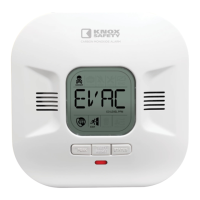TESTING AND MAINTENANCE
WEEKLY TESTING
WARNING!
• Test this alarm once a week. If the alarm ever fails to test correctly, have it
replaced immediately! If the alarm is not working properly, it cannot alert
you to a problem.
• DO NOT stand close to the alarm when the horn is sounding. Exposure at
close range may be harmful to your hearing. When testing, step away
when horn starts sounding. You can test this CO alarm by pressing the
Test/Reset button. The alarm will announce that it is about to perform a
test. Then, the horn will sound: 4 beeps, announce “Dangerous Level of
Carbon Monoxide detected! Evacuate immediately. Dial 911! Press status
button to repeat this message,” then 4 more beeps. If the unit does not
alarm, make sure it has been activated correctly and test again. If the unit
still does not alarm, replace it immediately.
WARNING!
• DO NOT try fixing the alarm yourself - this will void your warranty! If the
CO alarm is still not operating properly, and it is still under warranty,
please see "How to Obtain Warranty Service" in the Limited Warranty.
Install a new CO alarm immediately.
• NEVER use vehicle exhaust to test your alarm! Exhaust may cause
permanent damage and voids your warranty.
REGULAR MAINTENANCE TO KEEP THE CO ALARM IN GOOD
WORKING ORDER
• Test it every week using the “Test/Reset” button.
• Vacuum the CO alarm cover once a month, using the soft brush
attachment. Never use water, cleaners, or solvents, since these may
damage the unit. Test the CO alarm again after vacuuming.
WARNING!
Please dispose of or recycle the alarm properly, following any local regulations.
Consult your local waste management authority or recycling organization to
find an electronics recycling facility in your area. DO NOT DISPOSE OF ALARM
IN FIRE. BATTERIES MAY EXPLODE OR LEAK. DO NOT spray cleaning
chemicals or insect sprays directly on or near the CO alarm. DO NOT paint
over the CO alarm. Doing so may cause permanent damage.
IMPORTANT!
Household cleaners, aerosol chemicals, and other contaminants can affect
the sensor. When using any of these materials near the CO alarm, make sure
the room is well ventilated.
WHAT YOU NEED TO KNOW ABOUT CO:
WHAT IS CO? CO is an invisible, odorless, tasteless gas produced when fossil
fuels do not burn completely or are exposed to heat (usually fire). Electrical
appliances typically do not produce CO. These fuels include: Wood, coal,
charcoal, oil, natural gas, gasoline, kerosene, and propane. Common appliances
are often sources of CO. If they are not properly maintained, are improperly
ventilated, or malfunction, CO levels can rise quickly. CO is a real danger now
that homes are more energy-efficient. "Airtight* homes with added insulation,
sealed windows, and other weatherproofing can "trap” CO inside.
NOTE: This unit is sealed. The cover is not removable
13

